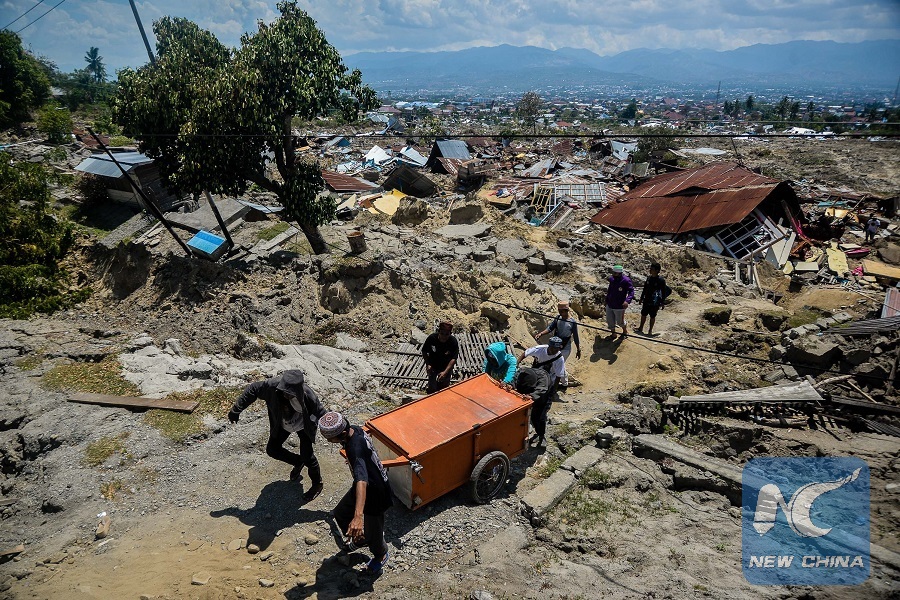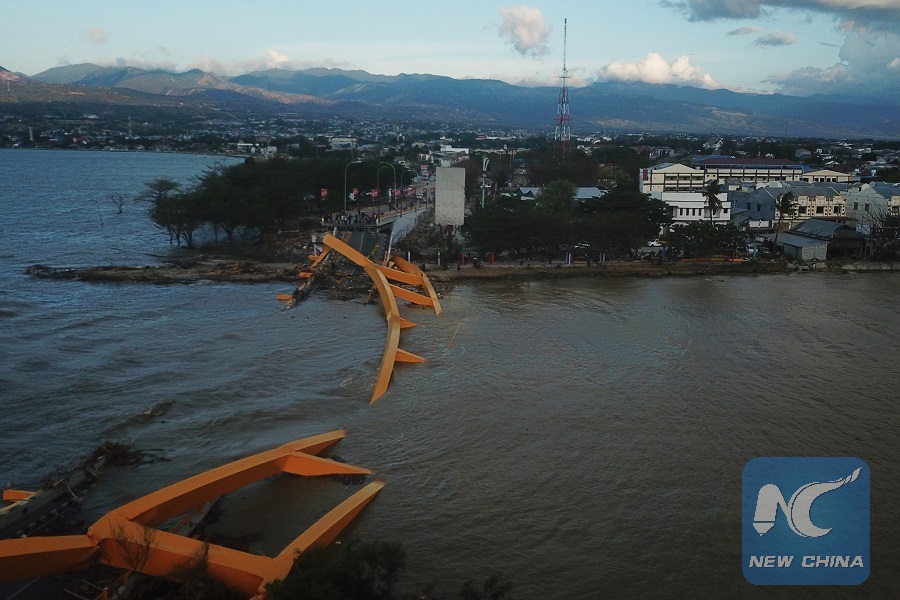
People salvage useable items from the debris of houses in Balaroa village after earthquake and tsunami in Palu, Central Sulawesi, Indonesia, on Oct. 2, 2018. (Xinhua/Iqbal Lubis)
by Zhu Ruiqing, Liang Hui
PALU, Indonesia, Oct. 8 (Xinhua) -- When night fell on disaster-hit Palu, the capital of Indonesia's Central Sulawesi province, Abdul Manan (alias) walked into the yard of his house with a pillow tucked under his arm.
In the tiny yard, carpets were spread out on the ground while tea and food was placed on the side. Abdul's family gathered together under a dim light.
Although 10 days have passed since the devastating earthquakes and an ensuing tsunami hit the region, Abdul and his family still do not dare to stay in the house at night. They sleep outside in the yard, for safety.
Survivors here are still haunted by the disaster, which has killed more than 1,900 people, with Palu being the hardest hit.
Abdul's house, which lies on the hillside, remained intact during the quakes and the tsunami. It became a shelter for many relatives after the catastrophe.
"Before the earthquake, this house accommodated four family members. Today, almost 10 people live here. Some of them lost their mothers while some lost their daughters. I am glad that I could provide a place for them to live during this difficult time. This is what family is for," Abdul said.
Now, every morning after the earthquake, Abdul goes to the seaside to offer help to those who need it.

A woman stands near the debris of a damaged mosque on Talise beach in Palu, Central Sulawesi,Indonesia. (Xinhua/Agung Kuncahya B.)
The natural disaster has taken a heavy toll on the city. The Arqam Baburahman Mosque on the seashore, one of the most famous scenic spots in Palu, was left in ruins. Its gate was torn off and the supporting pillars collapsed.
The fisherman's village Kampung Lere, opposite the mosque, was also totally destroyed.
In Palu's worst-hit area of Baloroa, it seems the buildings have been sucked into the ground. Yousefal Merag, director of disaster management and emergency from Kuwait's Red Crescent Society told Xinhua that "hundreds of villages have been affected by the quakes and tsunami. We are working together with local rescue forces to further assess the damage."
In spite of the devastation, people here are struggling to bring life back on track.
In Vatulemo Square Park in the heart of Palu city, dozens of tents were set up.
At sunset, some children were chasing each other while some were playing football. On the other side of the road, people were busy preparing dinner.
In the temporary supply distributing center not far from the park, workers were unloading boxes of water and instant noodles.
After the earthquake, a team from ZTE Indonesian branch immediately arrived in Palu to recover the local communication network.
Zhang Yafei, a senior executive of ZTE Indonesian branch, told Xinhua that the Chinese telecom giant has established a profound friendship with the Indonesian people in the past 15 years.
"The quake was heartbreaking," Zhang said.

Photo taken on Oct. 8, 2018 shows the aerial view of a collapsed bridge after the earthquake and tsunami in Palu, Central Sulawesi, Indonesia. (Xinhua/Wang Shen)
Business in Palu is gradually returning to normal, as banks and supermarkets re-opened, and trucks carrying supplies were back on the streets.
When Abdul came back home, his family was preparing dinner. "The disasters were horrible, but things will get better," he said.

